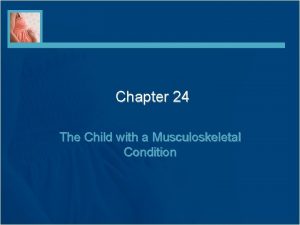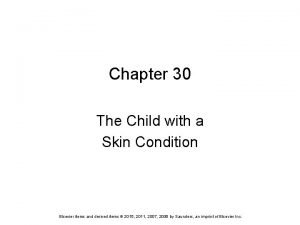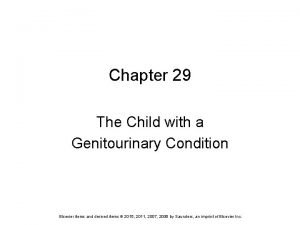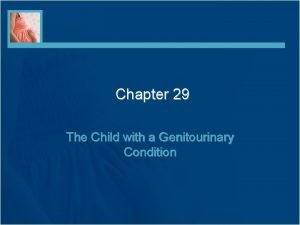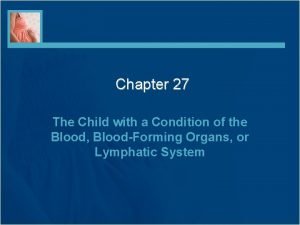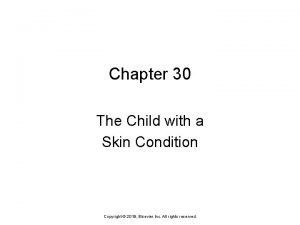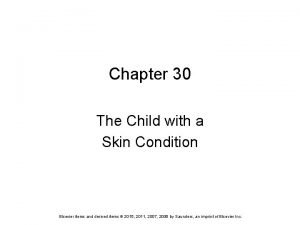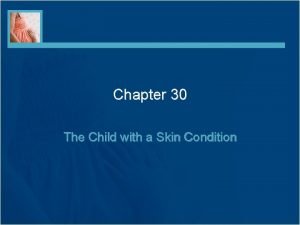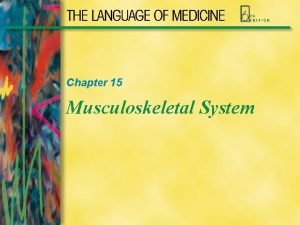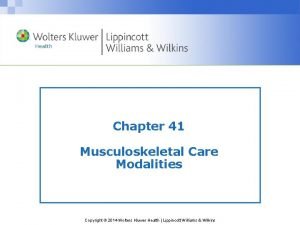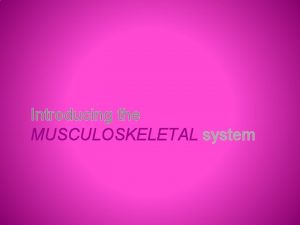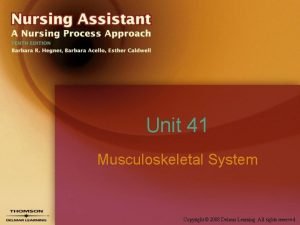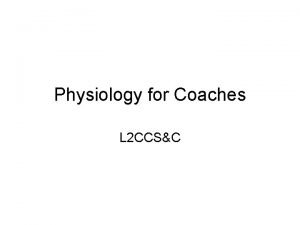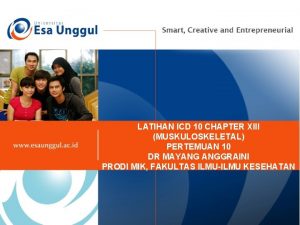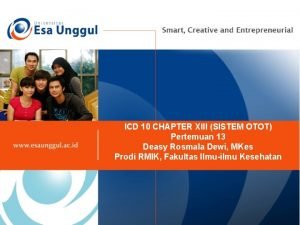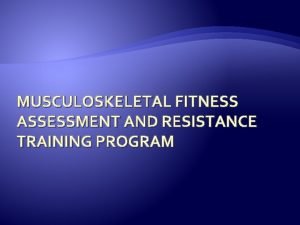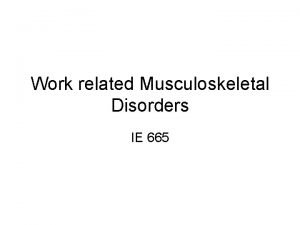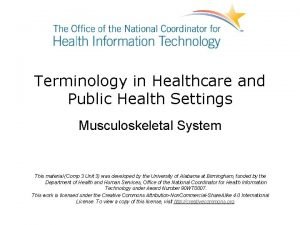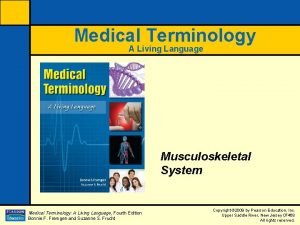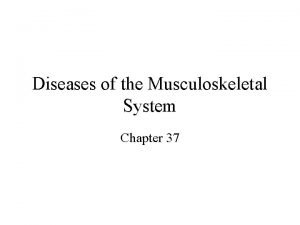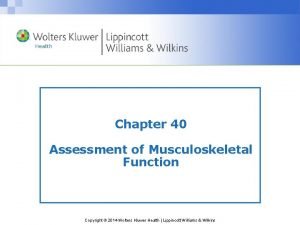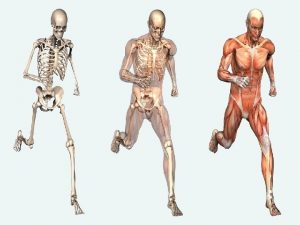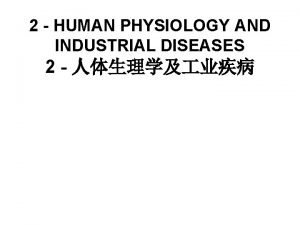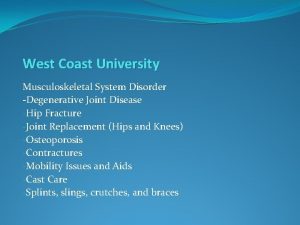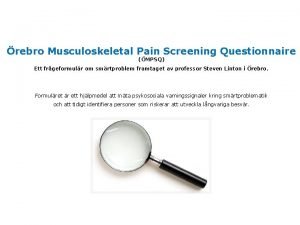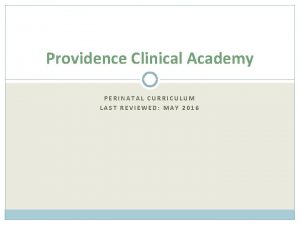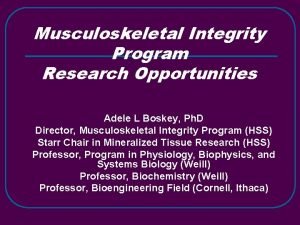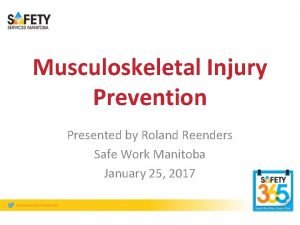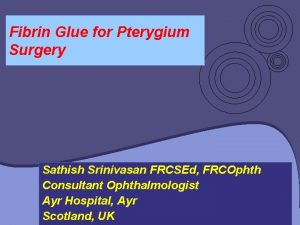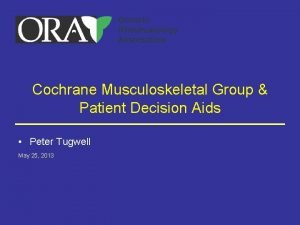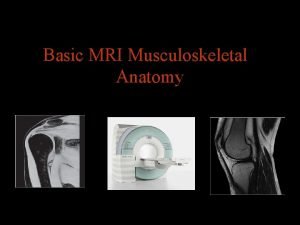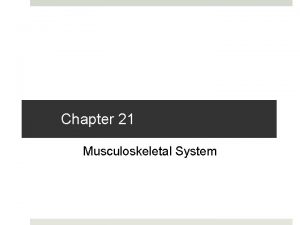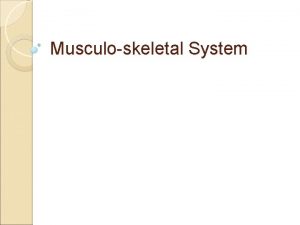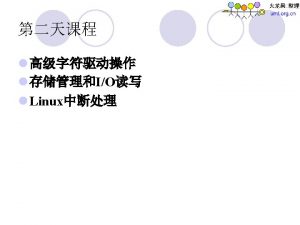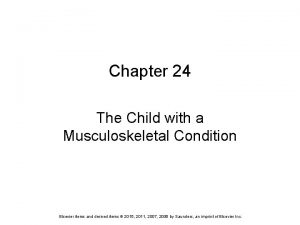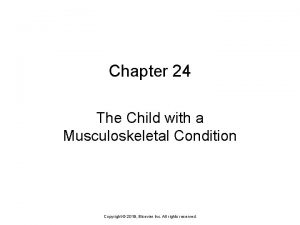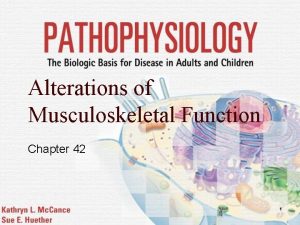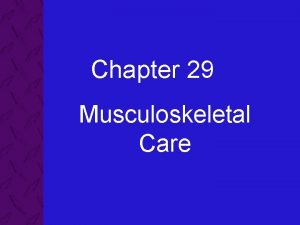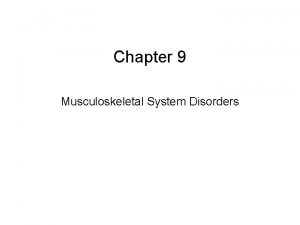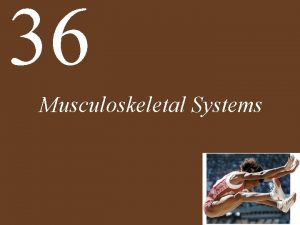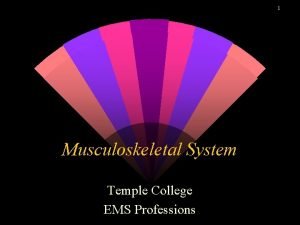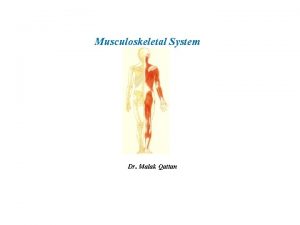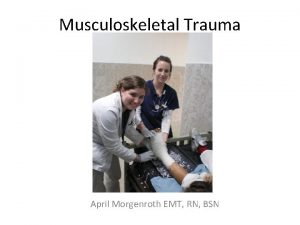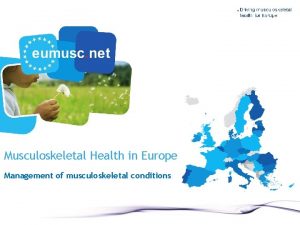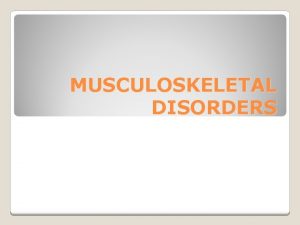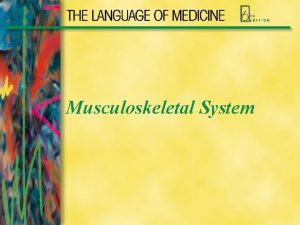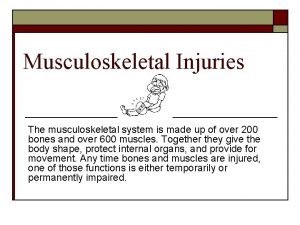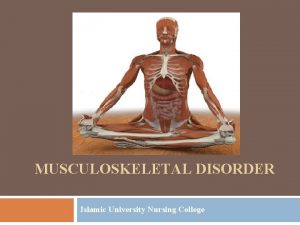Chapter 24 The Child with a Musculoskeletal Condition



































- Slides: 35

Chapter 24 The Child with a Musculoskeletal Condition

Musculoskeletal System • Supports the body • Provides for movement – Develops gradually and in an orderly manner in children – A marked slowing down of growth is always a signal for investigation

Newborn notes • • Limited ROM of hips Legs maintain a flexed position Newborn spine a “C” shape Feet usually turn inward or outward • Feet appear flat r/t fat pad @ arch

Observation of Gait • Children who don’t walk independently by 18 mo are delayed • Beginning walker unstable, but improves by 18 mo. • Toe walking after 3 yrs. can indicate a muscle problem • Young children appear bowlegged or knockkneed until age 5 • Usually toeing (pointing of the toe inward) in will clear by age 4

Tests & treatments • X-rays (radiographs) are taken to confirm suspected pathologic condition • Bone scans can see things not apparent on x-ray • CT shows cross-section • MRI has no radiation; produces detailed pictures • Ultrasound to r/o other causes

Pediatric Skeletal System • Epiphyses are present to allow for growth • Bone healing is rapid in children due to the thickened periosteum; a callus is formed quickly. Also a generous blood supply. • Approximate healing time: – – Neonate: Preschool: School-age: Adolescence: 2 -3 weeks 4 weeks 6 weeks 8 -10 weeks

Trauma/Soft Tissue Injuries • Contusion – tissue tearing resulting in hemorrhage, edema, pain • Hematoma – escape of blood into soft tissue • Sprain – when ligament is torn away from bone. Swelling, disability, pain. • Strain – microscopic tear to muscle or tendon occurring over time

Prevent trauma! • Parents are responsible for maintaining a safe environment for their children • Nurses are responsible for educating parents & teachers on how! • Car seats, pedestrian safety, bicycle helmets, pool fences, window bars, locks.

Soft tissue injuries • Treat immediately to limit damage • Cold pack & elastic wrap to reduce edema, bleeding & pain – On & off every 30 minutes • Elevate limb above heart • Frequent neuro checks • RICE them! – Rest – Ice – Compression – Elevation

Fractures • A fracture is a break in a bone – s/s: pain, tenderness with movement, swelling; discoloration, limited ROM, numbness • Simple: – Bone is broken, but skin over it isn’t • Compound: – Wound in the skin over bone; increased risk of infection • Spiral: – Caused by a forceful twisting motion • Greenstick: – One side of bone broken, one side bent – More common in children

Types of fractures

Fractures • Diagnosis & treatment: – X-ray most reliable source • bilateral views taken for children to compare sides – Traction • used when the cast can’t maintain alignment of the bone fragments • Traction aligns the injured bone by the use of weights & counteraction. Immobilization until the bones fuse

Types of traction • Bryant traction Used for treating fractures of the femur in children 2 years of age or under 20 to 30 pounds N. I. : • be sure traction ropes are intact and in the wheel grooves of the pulleys • Legs should be @ right angles to the body • buttocks lifted off the bed • continuous traction is necessary • the weights must hang free

Types of traction Russell Traction Skeletal traction: with a pin inserted into the bone and traction applied to the pin Russell traction: a sling is positioned under the knee to suspend the distal thigh above the bed. Skeletal Traction

Types of Traction • Buck’s Traction – – – Used in fractures of femur, hip, knee Pulls hip/leg into extension Used preoperatively Reduces pain and muscle spasms Keep patient feet off of the foot of the bed Primary nursing responsibility is to inspect skin regularly – Risk for impaired skin integrity r/t immobility

Checking circulation The nurse performs a neurovascular check to see if toes are warm and that their color is good. A serious complication of traction is Volkmann’s ischemia, which occurs when the circulation is obstructed.

Effects of traction

Neurovascular Assessment • Pain – Record location & quality of pain – Compartment syndrome is a serious complication to consider if pain does not respond to medication; is a progressive loss of tissue perfusion. • Pulse – Compare quality to unaffected side • Movement/Sensation – Numbness or tingling should be reported • Color – cyanosis of site distal to fracture can indicate venous stasis • Capillary refill – less than 3 seconds • Warmth

Safety Alert • The checklist for a traction apparatus includes – – – – Weights are hanging freely Weights are out of reach of the child Ropes are on the pulleys Knots are not resting against pulleys Bed linens are not on traction ropes Countertraction is in place Apparatus does not touch foot of bed

Safety Alert • Checklist for the patient in traction – – – – – Body in alignment HOB no higher than 20 degrees Heels of feet elevated from bed ROM of unaffected parts at regular intervals Antiembolism stockings or foot pumps as ordered Neurovascular checks performed regularly and recorded Skin integrity monitored regularly and recorded Pain relieved by medication is recorded Measures to prevent constipation are provided Use of trapeze for change of position is encouraged

Osteomyelitis • An infection of bone usually by staph • Usually r/t a local injury to the bone such as open fx, a burn or contamination during surgery. • Can be r/t skin abrasion, abscessed teeth or otitis media. • S/s: Hx of trauma or infection. – Fever, restless, localized inflammation & increased pressure cause pain, r/t purulent drainage in bone marrow. • Treatment & Nursing Care: – IV antibiotics for 4 to 6 weeks & pain relief

Bone Tumors • Osteosarcoma – A primary malignant tumor of the long bones – 2 most frequent malignant tumors in the child are osteosarcoma & Ewing’s sarcoma. – Usually occur 10 -15 yo. – Symptoms: pain & swelling at site; later, pathological fx may occur – Treatment: radical resection or amputation • Ewing’s Sarcoma – Cancer of the bone marrow in the long bones – Occurs mostly in older school age and early adolescent. – Treatment: Tumor is sensitive to radiation and chemotherapy • so amputation is generally not recommended

Juvenile Idopathic Arthritis • A systemic inflammatory dx affecting joints, connective tissues, & viscera. • Peak onset is 1 -3 yr & 8 -10 yr. • Goals of therapy – – reduce joint pain & swelling promote mobility, growth & development promote independent functioning help child & family adjust to a chronic dx. • Meds: NSAIDs, immune suppressant drugs, methotrexate, IV immunoglobins, antirheumatics • Occupational & physical therapy; psychological support • Morning tub baths, warm soaks & moist heat packs. No pillow or small flat pillow to promote body alignment

Scoliosis Lordosis Kyphosis Scoliosis

Scoliosis • Two Types – Functional - usually caused by poor posture, not spinal dx – Structural - caused by changes in shape of vertebrae or thorax • Treatment and Nursing Interventions – Curves up to 20 degrees don’t require tx. – 20 to 40 degree curves require a Milwaukee brace worn over a tee-shirt 23 hours a day. • Scoliosis Screening – examine the spine from the front, side & back while adolescent stands erect & then observing the back when bent over. Look for general body alignment & asymmetry

Milwaukee brace

Sports Injuries • Sports-specific • Common injuries examinations are given include for those involved in – Concussion strenuous activity on – “Stingers” or “burners” entry into middle school – Injured knee or high school – Sprain or strained • What are some prevention measures? ankle – Muscle cramps – Shin splints

Child abuse • Emotional abuse – verbal acts that destroy child’s self-esteem • Emotional neglect – intentional omission of verbal or behavioral actions that are necessary for dev of healthy self-esteem • Sexual abuse – act performed on a child for gratification of adult • Physical neglect – failure to provide basic needs of child • Physical abuse – deliberate infliction of injury on a child

Child Abuse

Nursing interventions • Identify high-risk infants & parents during prenatal & perinatal periods • Both verbal & non-verbal communications are important • Keep factual & objective records • An abused child is approached quietly; preparation for tx explained in advance; praise used when appropriate • Nurse must acknowledge there always two victims in child abuse

Assessing for child abuse

Assessing for child abuse • Bruises heal in various stages by color: – – – 1 to 2 days – swollen, tender Up to 5 days – red/purple 5 to 7 days – green 7 to 10 days – yellow 10 to 14 days – brown • Be suspicious of multiple bruises in various stages of healing!

Legal • Reporting suspected abuse or neglect – All persons who report suspected abuse or neglect are given immunity from criminal prosecution and civil liability if the report is made in good faith • Know what your state laws mandate for health care providers

Nursing Interventions for Abused and Neglected Children and Adolescents • • Teach child anxiety-reducing techniques Assist child in managing his or her feelings Teach child assertiveness skills Assist child in developing problem-solving skills • Assist child in value-building and clarification • Assist child in enhancing his or her coping mechanisms

Elsevier items and derived items © 2011, 2007, 2006 by Saunders, an imprint of Elsevier Inc. 35
 Buck's extension traction
Buck's extension traction Chapter 30 the child with a skin condition
Chapter 30 the child with a skin condition Chapter 29 the child with a genitourinary condition
Chapter 29 the child with a genitourinary condition Chapter 29 the child with a genitourinary condition
Chapter 29 the child with a genitourinary condition Chapter 27 the child with a condition of the blood
Chapter 27 the child with a condition of the blood Chapter 30 the child with a skin condition
Chapter 30 the child with a skin condition Chapter 30 the child with a skin condition
Chapter 30 the child with a skin condition Chapter 30 the child with a skin condition
Chapter 30 the child with a skin condition Profile tolerance symbol
Profile tolerance symbol The musculoskeletal system chapter 21
The musculoskeletal system chapter 21 Chapter 6 musculoskeletal system diseases and disorders
Chapter 6 musculoskeletal system diseases and disorders Chapter 15 musculoskeletal system practical
Chapter 15 musculoskeletal system practical Chapter 40 musculoskeletal care modalities
Chapter 40 musculoskeletal care modalities Musculoskeletal system
Musculoskeletal system Unit 41 musculoskeletal system
Unit 41 musculoskeletal system Musculoskeletal system
Musculoskeletal system Soal uas sistem muskuloskeletal
Soal uas sistem muskuloskeletal Kode icd 10 osteoarthritis genu
Kode icd 10 osteoarthritis genu Musculoskeletal fitness assessment
Musculoskeletal fitness assessment Work related musculoskeletal disorders definition
Work related musculoskeletal disorders definition Musculoskeletal pronounce
Musculoskeletal pronounce Inversion medical terminology
Inversion medical terminology Diseases of the musculoskeletal system
Diseases of the musculoskeletal system Assessment of the musculoskeletal system
Assessment of the musculoskeletal system Assessment of the musculoskeletal system
Assessment of the musculoskeletal system Musculoskeletal system
Musculoskeletal system West coast musculoskeletal
West coast musculoskeletal örebro musculoskeletal pain screening questionnaire
örebro musculoskeletal pain screening questionnaire Microganthia
Microganthia Musculoskeletal integrity
Musculoskeletal integrity Thank you pictures for presentation
Thank you pictures for presentation Spine pathology
Spine pathology Musculoskeletal
Musculoskeletal Musculoskeletal surgery ayr
Musculoskeletal surgery ayr Cochrane musculoskeletal group
Cochrane musculoskeletal group Musculoskeletal mri anatomy
Musculoskeletal mri anatomy
